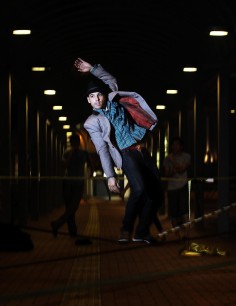Slacklining, a balancing sport, could take off like skateboarding
How much fun can you have with a piece of rope? Quite a lot, according to a growing band of Hongkongers

Jake Erlich fastens a rope between two poles at the Central ferry piers late on a Tuesday night. He tests its tautness before leaping, almost theatrically, onto the thin line. He wobbles momentarily before gaining balance.
Then, gliding along with ease, he explains why he and a growing number of "slackers" make this weekly pilgrimage to indulge in the unusual sport of slacklining.
"There is something about walking on a piece of rope that just feels good," says Erlich, 32, who hails from the US.
It's the springy, trampoline-like quality of the line, he says, and the simplicity of the pursuit of balance, that make it so much fun.
"Plus, when you nail something you've been working on - a jump, a new distance, or a new trick - it's like, 'Ah, that's just awesome. Did you see me do that?'" he adds.

Slacklining, which began in the late 1970s, was originally a way for rock climbers to hone their skills when the weather wouldn't allow them to climb. At first, they toddled along the chains between the pillars in car parks; next they slung their climbing ropes around the trees. Today, slacklining is shaping up to be the skateboarding of the new millennium. Slackers can be found on low lines, on high lines hundreds of metres above the ground, and traversing lines over water ("waterlining").
There's even slackline yoga. But the extreme junkies enjoy the potential for trickery that the ropes bring, a pursuit that's known as tricklining.
A number of specially developed slacklines have appeared on the market to accommodate the sport's growing scope. They're made of flat nylon webbing, and come complete with ratcheting systems for easy mounting. They are available in different lengths, and all the colours of the rainbow.
Slacklining has mainly been embraced by adventurous types - trail runners, mountain bikers and climbers - as a way to develop strength and balance. But it's quickly developing into a sport in its own right; world championships have been held since 2008.
The winning move at this year's competition was a backflip which landed on the 2.5cm-thick rope, and was then followed by a double backflip off the rope. It was a move that had to be seen to be believed.
In Hong Kong, Project X has pioneered the sport for the past 10 months, under the leadership of Andy Knight, 30, an avid rock climber. An extreme sports group with a benevolent bent, it holds slacklining meetings for the curious every Tuesday at Central Ferry Pier 9. (This requires a HK$20 donation to charity.)

One slacker walks on a 20-metre stretch of rope, while another performs impressive jumps before catching the rope with his toes, effortlessly regaining his balance.
Eager newbies are helped by seasoned slackers. Everyone has a favourite rope configuration, but the motivation is the same for all: to test their balance, agility and mental fortitude.
The feel-good factor is a common theme with the slackers here tonight. But the simple-looking endeavour does offer real challenges. "It requires intense concentration, core strength and balance," says David Tanner, 29, a slacker of five years. Tanner, a rock climber, says slacklining is now his sport of choice.
"Because it's so difficult, many people give up," he says.
Speaking from first-hand experience, it's easy to see why. Don't be fooled - slacklining is hard; really hard. The ropes shake violently beneath you when you first get on, and progress is slow.
After my first hour, I'd only managed to stand on the rope for a few seconds without falling off; I hadn't taken a single step.
Tenacity plays a big part. "If you're the type of person that can fail and then get back up, you will find it a lot of fun," says Tanner.
He's right, it's addictive.
"At first it's just about survival," says Knight, 30. "But then you start to learn all the crazy balance tricks and the spins, or you start to walk longer distances and go higher up," he adds. "It's still evolving. I know of people who set up slacklines on slopes, and then slide down in socks, trying to do tricks as they move down the line. It's crazy."
For former snowboarder Arisa Tanaka, 28, slacklining is all about the challenge. "It's difficult, as it's a balance sport," she says. "I also like it because it's become risky now I'm trying to do more difficult tricks. If I don't concentrate, I'll get injured."
The sport also involves a community spirit, which is driven by its competitive nature. The Slacklining Facebook group of Hong Kong was created by enthusiasts seven months ago. It holds regular weekend sessions on Hong Kong's beaches, where enthusiasts can attempt new moves with the knowledge that there's a soft landing below.
Certainly, competition plays a part. "There is a certain one-upmanship aspect to it," says Erlich. "You see someone do something, and you want to try it, too."
If you want to give slacklining a go, don't be discouraged by your initial failure. Because that first failure is guaranteed. Erlich says it takes most people at least three "tries" to pick it up, but from there, the sky's the limit.
Erlich, a distributor for the Gibbon brand of slacklines, knows this as well as anyone. He has developed into a keen exponent who likes to show off his signature move, "the surf". This entails shaking the rope with his feet while staying on, or "surfing the line".
The enthusiasm with which these characters approach their sport suggests slacklining is here to stay. But they agree it may be a bit too unconventional to ever catch on in a big way. "It'll never be a mainstream sport," says Knight. And Erlich agrees: "I think it's niche."